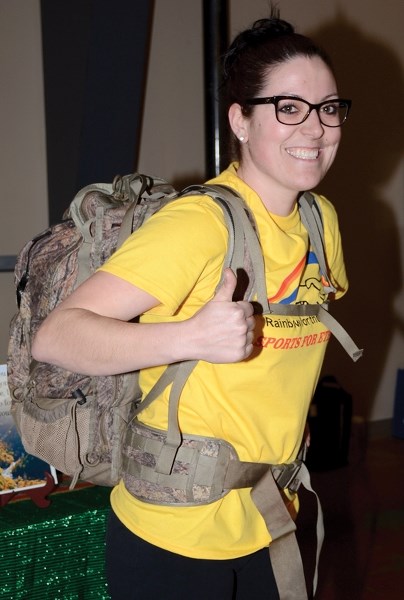The Rotary Spirit Centre was a hive of activity for the second annual Sports for Ethiopia March 17-18.
Local non-profit and international development agency Rainbow for the Future hosted its 24-hour sporting event to raise funds for a well and trench system in the Koka Lake area in Ethiopia.
Participants raised a minimum $200 and spent Friday evening to Saturday evening playing hockey, riding the spin bike, or walking five kilometres on the walking track — the same distance that women and girls in Koka Lake travel by foot twice a day to fetch 20 kilograms of water.
Guests were later served a banquet on both nights to refuel from the all-nighter.
Last year’s inaugural event raised $87,000 for orphans and HIV-positive women. Although the final tally won’t be available until the end of the week, Sarah Redding managed to raise $8,755.
Skater Dean Wiegand played a pair of games — one Friday from 11 p.m. to 1 a.m. and again from 3 a.m. to 5 a.m. Saturday morning. He was back on the ice again later that morning.
“My legs are starting to feel numb but it’s definitely a worthwhile endeavour,” he said.
Wiegand had gone to Ethiopia on Rainbow for the Future’s last trip and said it was a humbling experience.
“I’m an Alberta boy. When I got there, I was stretched in ways I never thought,” he said, pointing out that although the people didn’t have much, they still gave and showed their generosity.
On Saturday morning, Mary Anne Leriger and Kate Butler were on their sixth lap around the arena.
“We were just out with friends and they were talking about it so we decided to participate,” Butler said. “It’s a very worthy cause. Nothing more important than water.”
Leriger agreed.
“I think it’s a great cause,” she said.
Despite walking 25 laps the night before, she said she was “feeling good” and keeping her energy up.
Walkers also had the option of caring a backpack filled with 20 kilograms of water around the track, a luxury for the girls and women in Ethiopia who carry the jugs on their backs with blankets.
Rainbow for the Future chairman Leo Seguin said this year’s money will be used to drill a well and build trenches to bring water closer to the villages around Koka Lake.
“It’s an area where the women have to carry water five or six kilometres,” he said. “We’ve built some water wells there before, but in this situation the kids are dying from that water, but they have no choice. It’s the only water available.”
The Koka reservoir in south-central Ethiopia has been contaminated with industry and everyday human and animal activities.
Girls in particular are most impacted by hauling water, Seguin said, because it takes time away from school.
“For some reason women are tasked with hauling water, for the most part,” he noted. “They can be abducted, they can be abused, so we’re very adamant about doing this.”
Seguin has been involved with international development for over 30 years and will be making his eighth trip to Ethiopia this fall.
While working in the Koka region for the last 10 years, he became aware of the problems linked to the contaminated reservoir.
“We were brought into that area by a school teacher from another school. That was her home area — very poor area,” he said. “People there will hang themselves, they’ll drink battery acid because they’ve got nothing to eat or their families have nothing to eat. It’s a very poor area.”
He remarked that bringing clean water wasn’t the greatest thing about the project. Rather it was being there for those people.
“The greatest thing is the fact that you care, that you listen, that someone even in a country as far away as Canada is doing something about that, so that’s even more important,” he said.
“Poverty is like a cancer. It steals their self-worth, their self-reliance and then there’s nothing left because it’s a void. So we’re walking hand in hand. It’s not a hand out, it’s a hand up.”
Rainbow for the Future’s Barbara Wilson, who also doubles as the Rotary Club’s International Services chairperson, said the reason for various projects successes was through the local people’s involvement.
She said that the materials and people are Ethiopian — in some circumstances, the Ethiopian government has contributed money — so that the projects are self-sustaining and can be maintained by local partners.



